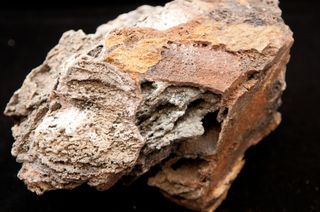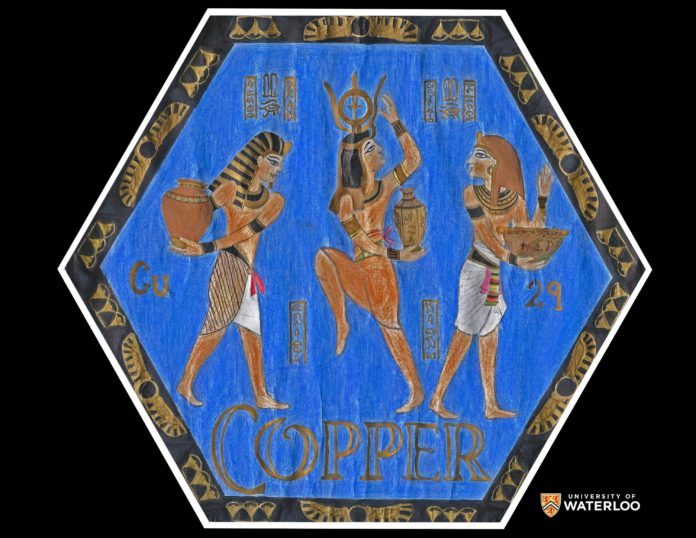Ziff—probably a metal used by Nephites
- Noah3 lays tax of fifth part of people’s ziff, Mosiah 11:3.
- Noah3 ornaments buildings with ziff, Mosiah 11:8. LDS Topical Guide
ZIFF. A metal, kind unknown, used by the artificers of king Noah in the land of Lehi-Nephi (Mosiah, 11:3, 8), The word ziff means, in the Hebrew, brightness—metallic brightness. (The word is used in Daniel, 2:31, also in Isaiah, 30:22, where it means overlaying metal.) Wikisource

The Story of the Book of Mormon by George Reynolds
“There are but few Nephite words handed down to us in the Book of Mormon, as wherever an English equivalent could be found, it has been given by the Prophet in his inspired translation. Those words are:
Neas and Sheum—Kinds of grain.
Ziff—A metal.
Rameumptom—A holy stand.
Gazelem—A name given to a servant of God.
Liahona—A director or compass.
Rabbanah—A title, meaning powerful king.
It has been wisely said, It is very evident that pure words of either the Hebrew or Egyptian tongues could hardly be expected in the Book of Mormon, for the reason that the Nephites had altered the Hebrew, and their language was so completely changed, that their speech could not be understood by other races. But although the structure of their language had thus changed, it does not follow that all the words had been replaced by others entirely unlike the former language spoken and written by them. It is logical to expect many remnants of the ancient roots, which, however much changed, may retain so much of their original types as to be capable of identification. Thus, in the word Ziff, which the Prophet Joseph tells us was a metal, we find a word of the same sound as the Hebrew word ziph or zeph, which means a metal. The metal laid over statues was so called. It is true that the word ziff is not spelled the same, but in its orthography is like the name of the Hebrew month, Ziff. But the word ziff means brightness—metallic brightness. (The word is used in Daniel ii., 31, also in Isaiah xxx., 22, where it means overlaying metal.)” The Story of the Book of Mormon by George Reynolds SLC 1888 page 372-373
Facts About Zinc

Smithsonite is a mineral form of zinc.(Image: © farbled
Bluish-silver zinc is a workhorse element, crucial to life and important in many industrial processes that often go unseen.
This metal is positioned on the Periodic Table of the Elements with the atomic number of 30, and was used by Greeks and Romans in ancient times, according to the Royal Society of Chemistry. But zinc was not as popular as copper or iron, according to a 2006 paper in the open-access journal Ancient Asia; it boils away at a lower temperature than is required to extract it from its ore, so ancient smelting techniques were not up to the task of isolating zinc.
Nevertheless, archaeologists have found a handful of zinc artifacts, including a sheet of zinc from Athens that dates back to 300 B.C. Today, the metal is used mostly as coating for steel and iron to prevent rusting, a process called galvanization. Incredibly, galvanization dates back centuries — The Royal Armouries of Great Britain include a collection of armor from India made in the 1680s which was galvanized by dipping in molten zinc. source:
Alloys Ancient use
Large black bowl-shaped bucket on a stand. The bucket has incrustation around its top. Late Roman brass bucket – the Hemmoorer Eimer from Warstade, Germany, second to third century AD Various isolated examples of the use of impure zinc in ancient times have been discovered. Zinc ores were used to make the zinc–copper alloy brass thousands of years prior to the discovery of zinc as a separate element. Judean brass from the 14th to 10th centuries BC contains 23% zinc.
Knowledge of how to produce brass spread to Ancient Greece by the 7th century BC, but few varieties were made. Ornaments made of alloys containing 80–90% zinc, with lead, iron, antimony, and other metals making up the remainder, have been found that are 2,500 years old. A possibly prehistoric statuette containing 87.5% zinc was found in a Dacian archaeological site.
The oldest known pills were made of the zinc carbonates hydrozincite and smithsonite. The pills were used for sore eyes and were found aboard the Roman ship Relitto del Pozzino, wrecked in 140 BC.
The manufacture of brass was known to the Romans by about 30 BC. They made brass by heating powdered calamine (zinc silicate or carbonate), charcoal and copper together in a crucible. The resulting calamine brass was then either cast or hammered into shape for use in weaponry. Some coins struck by Romans in the Christian era are made of what is probably calamine brass…
Strabo writing in the 1st century BC (but quoting a now lost work of the 4th century BC historian Theopompus) mentions “drops of false silver” which when mixed with copper make brass. This may refer to small quantities of zinc that is a by-product of smelting sulfide ores. Zinc in such remnants in smelting ovens was usually discarded as it was thought to be worthless.
A widely used zinc alloy is brass, in which copper is alloyed with anywhere from 3% to 45% zinc, depending upon the type of brass.Brass is generally more ductile and stronger than copper, and has superior corrosion resistance. These properties make it useful in communication equipment, hardware, musical instruments, and water valves. Wikipedia
Etymology
Given that ZIFF is mentioned twice in the Book of Mormon, once in the middle of a list of metals that were taxed, “a fifth part of their gold and of their silver, and a fifth part of their ziff, and of their copper, and of their brass and their iron” (Mosiah 11:3), and the second time in a list “of all manner of precious things, of gold, and of silver, and of iron, and of brass, and of ziff, and of copper,” it is likely that ZIFF is a precious or semiprecious metal.

The fact that this Lehite word is not translated but rather transliterated, probably indicates that Joseph Smith did not have an English word for it. Two metals that are natively found in the Americas with which the Prophet might not have been acquainted are platinum and the gold alloy tumbaga.[1]
The biblical GN Ziph in Joshua 15:24 and the PNs in 1 Chronicles 4:16 and 2:42 (King James Bible has Ziph for both the GN and the PN name; the masoretic text has zîp for both)[2] would seem to offer the closest analog to Book of Mormon ZIFF. However, no etymology is given for either the GN or the PN.
If ZIFF were shiny, like many metals, it would be tempting to equate ZIFF with the HEBREW vocable ziw, “glow, complexion.”[3] It is possible that this is the source of the HEBREW month name Zif (King James Bible 1 Kings 6:1 for the HEBREW ziw), meaning, the month of blooming. It is probably related to Akkadian zīmu, “appearance, luster, glow.” As tempting as this suggestion might be, it is not without its difficulties. Book of Mormon clearly ends in a consonant, /f/, and none of the Semitic cognates of HEBREW ziw end in a consonant, except possibly Punic zyb. Furthermore, none of the translations of the 1 Kings 6:1 transliterate the HEBREW ziv with a final /f/ or a /p/, until the Matthew Bible, Zif, the Geneva Bible, Zif, and then the King James.[4]
Less likely is that Book of Mormon ZIFF may be something other than a metal, in which case we should consider the possibility of HEBREW zepet, “pitch, bitumen, asphalt” (Exodus 2:3; Isaiah 34:9), which appears also in Samaritan (zefet) (Rosenthal, Aramaic Handbook II/2, 4) and in Arabic as dift. Cf. EGYPTIAN sft, name of one of the seven oils, Demotic syf/sfy, resin of coniferous trees, and Coptic sife, “tar” (JAT). https://onoma.lib.byu.edu/index.php/ZIFF

Middle and east Tennessee districts
In middle and east Tennessee, six mines produced zinc from Mississippi Valley-type deposits. The mines were: the Coy, Immel, and Young mines in east Tennessee, and the Gordonsville, Elmwood, and Cumberland mines in middle Tennessee.
Smelting
Primary smelters produce metal from ore. The only American primary zinc smelter, the Nyrstar smelter at Clarksville, Tennessee, produced 115 metric tons of zinc, from a mix of ore from six mines in middle and east Tennessee, and recycled zinc products.
Secondary zinc smelters produce zinc from recycled materials. A secondary zinc smelter in Pennsylvania closed in 2014, the operations being shifted to a new smelter in North Carolina using solvent extraction/electrowinning (SX/EW). In addition, some non-smelting zinc recycling operations produced small amounts of zinc. The total amount of zinc produced from secondary operations was 70 tons. For primary and secondary smelters taken together, recycled products accounted for 52 percent of the refined zinc produced in US in 2014.[3]
Through 1940, the production of primary zinc by US smelters approximated the mined production of zinc ore. When zinc demand increased during World War II, US smelters turned to foreign zinc ore. US-smelted zinc reached a high of 926,000 metric tons in 1970, then dropped as smelters closed. There were 12 primary zinc smelters in 1970, but only 7 in 1980, 3 in 1990, and two in 2000. Today, there is only one operating primary zinc smelter, in Clarksville, Tennessee, which produces zinc from mines in the East Tennessee and Middle Tennessee districts. All other zinc ore is exported, and smelted abroad.
https://en.wikipedia.org/wiki/Zinc_mining_in_the_United_States
Summary: It seems the word Ziff only existed since the year 1746, just after Joseph Smith used the word in translation. However the metal that was used to galvanized copper and steel was in use anciently under another name, possibly Zinc as we see above. In Hebrew, the word zîw means “splendor” or “brightness” which very well could be Zinc.




